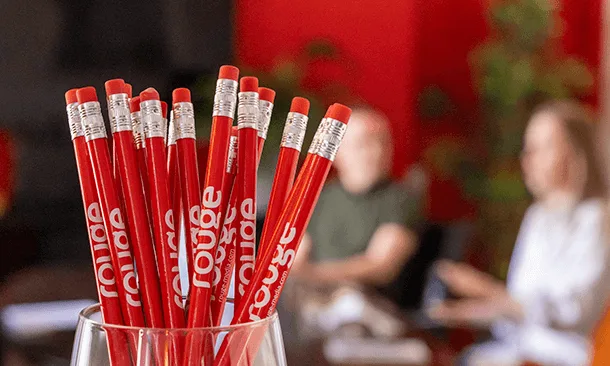Fix your website UX. Fix your leads.

You’ve got plenty of traffic, but why aren't they converting?
If your site looks good but isn’t converting, you may think it’s one of these common issues: Design features, copy, poor branding, maybe your target market, or maybe you even need a new website?
But in most cases, what’s holding you back may not be obvious at first glance. Small gaps within your content flow, visual consistencies, layouts, labels and signposts can all add up to a poor user experience that’s quietly killing your results.
The good news is, you probably don’t need to tear down your whole site and start again. It’s likely you can make big progress by fixing what’s already there.
At Rouge we care about making better websites. Not just shiny-looking ones. But websites that actually work for the people using them. The relative ease and simplicity with which content can be navigated and actions taken is what shapes how someone feels when they land on your site. That’s good user experience. It’s how quickly they find what they need and whether they stick around, or not.
Because when it comes to websites, you’re most commonly going to get one chance to engage a visitor. Today’s users are thinking fast, often very savvy and they will respond quickly. This means often – and quite rightly – backing out and going elsewhere at the first sign of an obstruction to their pursuit of their goal. If that first experience is slow, confusing or frustrating, users won’t give your brand another thought. This is where you simply ask yourself; can I afford to let potential customers slip through my fingers because of oversights in the quality of their experience on my website? Didn’t think so.
What this article covers:
- Your website might look great but if conversions are low then you probably have gaps in your UX strategy.
- We break down 5 common UX gaps that kill conversions: confusing, inconsistent or hidden CTAs, poor mobile layout, lack of clear flow and visual hierarchy, slow load time, and generic messaging.
- Fixing your website’s user experience doesn’t necessarily mean a website rebuild. It’s about removing friction, guiding users and getting more from your existing traffic.
- Better UX considerations can mean big reductions in bounce rates, higher quality leads and stronger conversion results.
- Rouge maps user journeys based on audience data and questions, and optimises your website around real behaviours, requirements and tasks, so your website starts converting the way it should.
Great UX doesn’t just look good. It converts.
Fixing your UX gaps isn’t about making your site look prettier (that’s just a bonus).
Instead, it’s about making your site as easy as possible for people to use and do what they came there to do without much thought. Maybe that’s buying something, booking a call, downloading a guide, or finding the answer to a question.
Why do you want to prioritise making it easy over stunning? Look at the success of Amazon – they have never been known for a beautiful website. But that matters less when your primary goal is conversions. If your site makes anything confusing, slow, or annoying, users will leave in a heartbeat and go find a better one.
The result: few conversions, a forgotten website, repeated missed opportunities for your brand, and ultimately, your bottom line.
The five UX gaps that are quietly costing you leads.
If your site is suffering from a lack of enquiries, sales or clicks despite having invested a lot of time and money in it to work and look great, here are some of the gaps we most often see when clients tell us that their traffic is good but not converting:
1. Confusing, inconsistent or buried Calls To Action (CTAs)
You’d be surprised at how many websites hide their CTAs or have seven or more different button or link colours in various places. Often CTAs are under-emphasised, poorly written or obscurely placed – all of which result in people overlooking them, and therefore not doing what you want them to.
A good CTA asks users to take action at a natural-feeling point in the flow of content. It should be brightly coloured, clearly placed, thoughtfully written and with high colour contrast between text and background. If it’s vague in any way, hidden in a strange place, looks the same as everything else on the page, or tries to do five things at once, expect poor results.
Make them specific, obvious, and relevant to their featured page and the content in it to ensure users take the desired action. For example: “Schedule a free demo” or “Speak to one of our team”.
2. Poor mobile layout
Over 50% of web traffic now comes from mobile, according to Statista, and yet still to this day, some sites do not provide a great mobile experience. This includes slow load times, fiddly menus that don’t work properly, layouts that break and buttons that are too small to tap.
Not only is this very frustrating for users, but it doesn’t give a positive first impression of your brand, often resulting in users bouncing.
Many agencies will tell you to design “mobile first”. The principle here is right; to consider mobile from the outset. But it’s not necessary to stop – or start – at one screen size first. At Rouge, we design for all screen sizes first, creating them in parallel.
This means experiences that adapt beautifully across all viewport sizes from the very start. This includes testing smaller elements on smaller screens, examining the ease of thumb tapping, and ensuring the layout flows effortlessly, no matter how or where it’s viewed.
3. Lack of clear flow or visual hierarchy
Hierarchy gives your content structure, making it flow. Hierarchy tells your visitors what’s important, what’s next, and what they should do. If your pages are trying to say everything to everyone, with multiple visual elements all shouting for attention in equal measure, this will kill conversions.
Provide an easy, enjoyable journey by giving each page a job. Ask yourself: What should someone do here? Where should they go next? Where might they want to go next?
A good rule of thumb is to remember that each page needs one clear focal point. So, one message should be noticed first, and one action should be taken.
To improve clarity and flow:
- Avoid too much information.
- Use visual cues (headings in sequential font sizes, layouts and colour) to guide attention.
- Break up the content into clear sections to improve scannability.
- Unless an article or a low level page discussing a specific topic, avoid at all costs large blocks of written content.
- Prioritise the message you most want them to see.
- Structure content so each decision and step feels obvious, straightforward and progressive. It should all feel like a logical path to a destination.
This will help make your site easier to navigate, meaning visitors find what they came for, or are even drawn into something they didn’t, resulting in longer time spent and ultimately, conversions.
4. Slow load time
Speed matters. A lot.
According to Forbes, “40% of users will leave a site if it takes more than three seconds to load.” That’s 40% of potential conversions leaving before they’ve even seen anything. A site that takes forever to load feels clunky, unreliable and outdated. It says a lot about how much you care about your visitors’ experience, whether you, or they, realise it.
A slight delay is enough for even the most determined user to change their mind.
Large image files, bloated code, too many third-party plugins, and a lack of caching and CDN setup may contribute to a slow site.
Focus on fixing this as soon as you notice any lag, to set your site up for better load time performance and that crucial positive user experience.
5. Generic messaging
If your homepage sounds like everyone else in your industry, packed with buzzwords like “Innovative solutions for modern businesses” or “helping businesses scale, grow and lead”. Then there’s a problem.
Users don’t trust what they don’t understand, and if your messaging isn’t conveying anything real and different, expect crickets.
Focus on being specific about exactly what it is that you do and for who, and what makes you different to the rest. Use direct language with your brand personality to build a more personal and human connection with your audience. If your brand doesn’t give you the tools to do this, Rouge can help here too.
Taking note of these 5 gaps and fixing them will only enhance your users’ experience.
The business impact of better UX.
When your site works the way users expect it to, everything is easier for them, including conversion. Making your entire sales funnel more efficient.
You’ll notice:
- More people taking the next step
- Lower bounce rates
- Higher conversions
- More qualified leads
- Stronger trust in your brand
Not only does improving your website in this way provide a smoother user experience, but you’ll also be able to track measurable results.
How Rouge approaches UX.
At Rouge we don’t guess. We plan.
We begin by understanding who your audience is, what they are actually looking for and trying to do. Then we then build every flow, layout and message in support of that. Because if the user doesn’t enjoy their experience and get what they need from your website, then it’s not working at its optimum, you’re missing opportunities and ultimately, damaging your brand.
Before anything else, we start by answering who is your audience and what are the objectives and motivations of your website’s users? What are they trying to achieve? What can we show them along the way, and what’s getting in the way of that?
From there, we map out everything from content, layout, flow and more, all centred around building an easy, clear and fast user journey.
Here’s what that looks like:
- We map out real user journeys using the best data we can find on your audiences.
- We structure pages to guide decisions without overwhelming users.
- We use this process to help us spot friction and obstacles early.
- We design around user behaviour, not internal assumptions or motivations.
- We sit conversion at the forefront of each element that is promoting it.
- We continue working with you and optimising post-launch.
It isn’t just about providing a fresh look for your website, it’s about making it work hard for you. Find out more about how we develop websites at Rouge.
Final thoughts.
If your website looks good and traffic is great, yet the results aren’t delivering, it doesn’t mean your site is broken beyond repair, it’s probably just underperforming.
Focus on working with what’s already there and pinpointing the gaps in your UX that are impairing conversions, and can be fixed. If you’re not sure how, we can help.
That’s exactly what we do here at Rouge. So if you don’t have the time or the knowledge to pick apart the issues you’re having, let’s have a chat and we’d be happy to help you reach your conversion potential.




